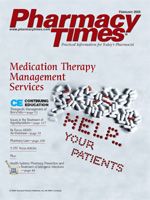Publication
Article
Pharmacy Times
Considering Adding Disease State Management Services?
Author(s):
On August 3, 2004, the Centers for Medicare andMedicaid Services proposed a rule to include MedicationTherapy Management Services (MTMS) aspart of the Medicare Prescription Drug Benefit. This regulationhas the ability tochange the face of communitypharmacy practiceby offering compensationfor pharmacists toprovide MTMS.
The first step towardmedication managementis understanding andmanaging the disease statethat warrants the medication.It is very importantwhen community pharmaciesare creating medicationmanagement programsthat this significantpiece of the puzzle is notoverlooked.
The next step is todecide what services canbe offered for certain diseasestates and medicationmanagement. Thisarticle will discuss 3 disease state/medication managementprograms that have been successful in a community pharmacysetting and the measures needed to implement them:hypertension, hyperlipidemia, and diabetes.
Hypertension
Monitoring hypertension involves assessment of bloodpressure (BP) on a routine basis as well as education in propermedication utilization. One way to incorporate both ofthese ideas into a valuable service is the "Blood PressureClub."This service consists of offering BP readings as well asmedication management for a specific fee, dependent onthe duration of membership. For instance, a 1-month membershipmay give patients the opportunity to come in asoften as they choose, during normal business hours, for a BPreading and medication management.
The resources needed to start such a program include aconfidential area in which to meet with patients, a sphygmomanometerwith a stethoscope, charts to record visitinformation, and appropriate patient education materials.The visits should include measurement of BP and a completemedication history, and any recommended changes intherapy should be provided to the patients'physician forreview. This valuable service allows the pharmacist to assistin the management of patients'hypertension, while buildinga provider relationship with their physicians.
Hyperlipidemia
Technology has provided a safe and efficient way to monitorcholesterol and liver function outside of the doctor'soffice or hospital. A system such as the Cholestech LDXallows the pharmacist to collect a blood sample by a fingerstick and to run a complete lipid panel or test alanineaminotransferase (ALT) in just 5 minutes. The results can beprovided to the patient and the physician and can be interpretedduring the initial visit. The resources needed to startthe program include a confidential area to test cholesteroland conduct visits, appropriate Occupational Safety andHealth Administration Blood Borne Pathogen training forparticipating pharmacists, the testing machine and materialsneeded, charts to record levels and visit information, andappropriate patient education materials.
Monitoring cholesterol levels can identify patients withunknown hyperlipidemia who need referral to a physician.For patients with diagnosed hyperlipidemia, monitoringlevels provides an assessment of progress made throughlifestyle modifications or medication management. Manypatients on medication for cholesterol also will need to havetheir liver function assessed routinely. A system such as theCholestech LDX can be used to monitor ALT liver function,and levels can be provided to the patient and the physicianin just a few minutes. The cholesterol service is quicker,more convenient, and oftentimes cheaper for patients withlimited or no insurance coverage for laboratory work.
It is important to understand that the assessment of cholesterolis only a screening tool that will determine how thepatient visit should be completed. The greatest feature of thepharmacy service is not measuring the cholesterol levels, butinstead providing education in managing these levels. Thepharmacist must interpret the different measurements on thecholesterol panel (total cholesterol, low-density lipoprotein,high-density lipoprotein, and triglycerides) and provide goalsfor each. Patients must be assessed for cardiac risk based onestablished risk factors and should be referred to a physicianimmediately if goals are not met. At each visit, the pharmacistmust reinforce the need for lifestyle modification and providepatients with their own personal dietary and fitness goals.
The success of this program depends greatly on establishingopen lines of communication with each patient's physicianand gaining trust and respect through repeated correspondence.A great benefit of an established relationshipwith a physician is that, when patients present with a needfor referral, the pharmacist will know whom to call.
Diabetes
Diabetes as a disease requires extensive education, complicatedmedication therapy, routine monitoring, and intensivelifestyle modifications. The needs of patients with diabetesopen many doors for community pharmacy services.One of the many possible services is blood glucose metertraining. A meter training service requires only a confidentialspace in which to conduct the patient visit. The pharmacistcan educate the patient on everything there is toknow about the meter and blood glucose monitoring. Thiseducation is often neglected in a doctor's visit due to timeconstraints. When it is given in the counseling window ofthe pharmacy, it may be condensed to a 5-minute review.
Meter training service involves how to change settings andall the operations of the meter, how to use the lancet andstrips to test appropriately, goals for blood glucose levels,when to test, and education on the importance of recordingreadings for managing diabetes. This service offers more thanis expected in a normal counseling session, and most patientswill recognize its value.
Conclusion
This brief description of pharmacy services does not beginto capture all the opportunities available. It is hoped, however,that this article has provided some insight into howsome pharmacies have gotten started in providing MTMS.
Dr. Downing is a clinical coordinator for Kerr Health Care Center,Raleigh, NC.







